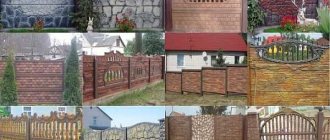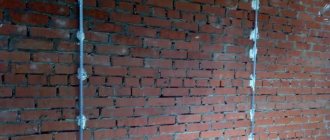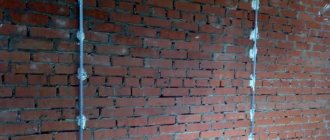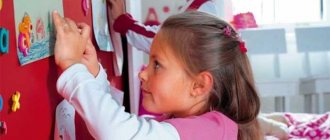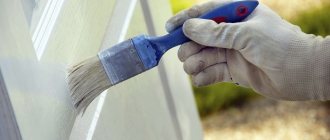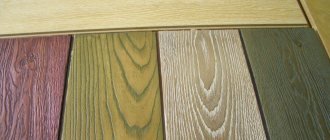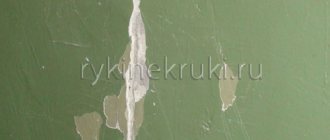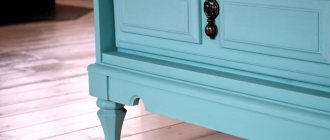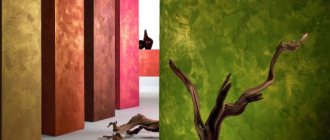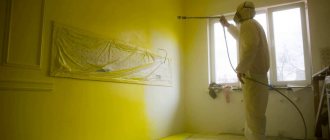The use of painting to decorate walls and ceilings is a very popular solution, allowing you to get a seamless, beautiful finish in a fairly short time. The so-called is distinguished by its special beauty. “textured” paints, the application of which is somewhat different from conventional material.
- Pros and cons of textured paint
- Types of textured paint
- Preparation before painting
- Preparing textured paint
- Applying textured paint
- Additional effects and drawings
Pros and cons of textured paint
Textured paint refers to a homogeneous material in the form of a dense mass of white color. This substance is most often produced on the basis of acrylic, which gives it excellent characteristics and opens up wide possibilities for use. By introducing various pigments into the composition of such paint, one can achieve one or another shade of the surface. As for silicate and silicone compounds, they are less common due to their high cost and susceptibility to fungi and mold.
Textured paint
The advantages of the material include:
- Reliability. This is ensured by a durable acrylic base. The fact is that acrylic is not afraid of moisture, resists abrasion well, does not accumulate static electricity, and does not support combustion. The surface painted in this way perfectly withstands direct exposure to the sun without fading over time.
- Easy to apply. Although there are some nuances in working with structural paint, anyone, even a beginner, can master this procedure.
Applying textured paint
- Easy maintenance. The finished finishing surface is antistatic, which significantly reduces the amount of dust settling there. In addition, the moisture-resistant characteristics of the finish allow you to wash off various contaminants from it (including drawings with a felt-tip pen or pencil, which is often found in children's rooms).
- Harmlessness. The components included in the textured material are non-toxic, which allows them to be used without restrictions in any room.
- Masking minor flaws in the base. The presence of texture makes it possible to hide small defects up to 2 mm using this paint. This greatly simplifies the preparation process (especially grinding).
- High decorative characteristics. Using structural paints you can significantly transform any room.
Textured paint
The disadvantages of finishing usually include some difficulty in its application (compared to conventional paint) and the effect of clogging the room, which occurs due to the formation of a waterproof film on the surface being finished.
Tips for choosing paint
Textured paint is made from various base materials into which one or another filler is mixed. At the same time, the working qualities of the coating depend on the properties of the base, i.e. basics. Let's consider which compositions are best suited for application in different rooms.
Bath and kitchen paint
The kitchen and bathroom are wet areas. This means that the coating must be resistant to moisture and allow periodic cleaning or washing using special products. For such conditions, acrylic-based textured paints are most suitable. They have a successful set of working qualities and have a wide selection of colors. Allows you to get many relief options.
Paint for living rooms
As a rule, silicate-based compounds are used for finishing living rooms. It is recommended to use compositions with the effect of wet silk, bark beetles or other materials with low relief. More expressive compositions require larger areas and distances in order to fully appreciate the effect of the coating.
Types of textured paint
According to the type of decorative effects created, textured paints are divided into the following types:
- Mizuri. In addition to acrylic, the substance contains modified starch, which makes it possible to obtain both a structural and smooth effect when applied. This or that texture depends on the laying tool used.
Textured paint "Mizuri"
- Marseille wax.
With this paint you can achieve a very realistic imitation of natural stone and balsa wood. Like Mizuri, Marseilles wax can produce a smooth or textured effect. To be fair, it is worth noting that in this case it will not be possible to obtain a completely smooth surface - the small depressions will still remain after smoothing. To protect against moisture and increase decorative qualities, a layer of wax is applied to the dried surface. Textured paint “Marseille wax” - Atacama.
The material has outstanding external qualities: the finish plays with numerous colors when viewed from different angles. This effect is achieved thanks to the quartz sand included in the paint and special metallized additives that form a reflective layer. In appearance and when touched, the finish creates a velvety feeling. Textured paint "Atacama" - Relief.
Acrylic components in this case are reinforced with quartz sand and a number of other substances, which makes it possible to create pronounced patterns. Relief paint is not suitable for creating a smooth surface. It is this finishing option that is considered the most striking representative of textured paint. Textured paint “Relief”
Possible invoice options
There are several common types of relief that are given to textured paint. Usually the choice depends on the type of filler and grain size. It is necessary to take into account that each type of pattern can be diversified, or you can come up with your own method of application. The type of coating always depends on who applied it. Each master has his own skills, abilities, and uses tools differently. Let's look at the most popular types:
Marseille wax
This is a composition with a wax filler. The finished coating resembles the surface of a stone, with a soft matte sheen. The relief is not high, but very expressive due to the combination of darker and lighter areas. The general appearance of the surface is stylish, noble, suitable for luxury premises.
Mizuri
To obtain the Mizuri relief, paints filled with modified starch and acrylic dust are used. The pattern consists of smooth wavy lines that look like the surface of multilayer sedimentary rocks. There is a wide choice of coating colors. The surface has a low gloss. Application is carried out only by hand, without rollers or additional devices.
Relief "bark beetle"
To obtain such a pattern, granite or marble chips are mixed into the paint. When applying, the surface is treated with a regular grater. Crumb particles are captured by the plane of the tool and form grooves, very similar to traces of insect activity on wood. The relief is very popular, it forms an attractive and not too catchy pattern. There are many compounds with the “bark beetle” effect. It is recommended to use single color materials as they look best.
Atacama
The matte velvety surface with sparkles is formed by a composition filled with quartz sand and metal particles. The relief has several application options:
- weathered sandstone. This is done using wave-like movements of a spatula over a freshly applied layer of paint;
- travertine The surface is rolled with a foam roller and then lightly smoothed with a spatula to obtain the effect of a sandy wall;
- wood. A special rubber stamp with a semicircular surface is used. It is carried out vertically, shaking the round part so that a pattern remains, similar to a cut of wood;
- bark. It is done in two stages - first, vertical stripes are made with a plastic brush, which are then smoothed with a spatula in the same direction.
The Atacama relief is attractive, but requires the artist to have some experience working with textured paint.
Wet silk
The paint composition includes a filler made of cellulose or cotton fibers and polymer tinting compounds. The height of the relief is small, but the decorative effect arises from the iridescent areas of the coating. Outwardly, it resembles silk or velvet fabrics. used to decorate walls in an apartment or public space, restaurant, etc.
Concrete effect
This paint contains a fine mineral filler. It is usually applied in a single color to create a realistic imitation of a concrete wall. However, some artists prefer to mix two colors to achieve greater graphic expressiveness of the design. Apply with a regular foam roller.
Preparation before painting
This stage is very similar to preparing for the application of usually water-based paint. However, due to the greater viscosity of the textured composition, the strength requirements for the base in this case are an order of magnitude higher.
Operating procedure:
- Preparing the premises. Carrying out repairs of this type is accompanied by the formation of a large amount of dust and dirt. Therefore, it is recommended to completely empty the premises of all furniture and decorative items, remove chandeliers and lamps. Those items that cannot be removed due to their size should be moved to the center of the room and covered with film. Also, the entire floor area is covered with polyethylene (if the final floor finishing has already been laid).
- Stripping off the old finish. The walls and ceiling (if it will also be finished) are cleaned of all old finishing. Ideally, bare panels or plaster should be left. All fragments of the rough base that do not hold well and vibrate when touched must be beaten off with a hammer or pick. The cleaned surface is thoroughly impregnated with primer.
- Plaster, putty. After the primer has dried, a leveling layer of plaster or starting putty is applied. As a rule, the walls are leveled with plaster, and the ceiling with putty. At this stage, it is important to achieve visual smoothing of all irregularities, for which you can use the rule and beacons. If the base is mostly flat, apply finishing putty immediately (in 2-3 layers).
- Grinding. After waiting for the last layer of putty to dry completely (this usually takes at least a day), sanding is carried out using painting sandpaper (No. 120-140). If in the future you plan to use decorative paint that forms a texture, you can be lenient with minor scratches during sanding: they will not be noticeable on the finished surface.
- Finishing primer. A very important stage, since it is important to achieve the most uniform thickness of the primer layer over the entire application area. Otherwise, the finish will contain unevenness. It is recommended to use acrylic impregnation as a material, coating the base with it in 1-2 layers. The pause for drying one layer is approximately 6 hours.
How to prepare walls
Full painting of walls with textured paint requires their preliminary preparation. You need to get rid of the old coating, remove dust and dirt from the walls. If there are cracks or crevices, they are puttied. Next, a layer of finishing primer is applied to the wall. It is needed to ensure high-quality adhesion of the material to the base of the wall. The primer should eliminate all unevenness present on the surface; it will give the patterns expressiveness and uniqueness.
Wet the wall with a damp cloth and apply a thin layer of primer to it. After 4-24 hours (drying time for the primer), you can apply the decorative finishing to the wall. Working with textured paints differs from applying conventional paints to the surface. First, the paint is heated to 20 degrees, if the consistency is thick, water is added to it. The time for complete drying of the paint is 24 hours.
Preparing textured paint
Before applying textured paint, you must carefully read the attached instructions. It contains information about drying time, preparation procedures and application recommendations. This type of material is usually sold in plastic buckets.
Textured paint
The consistency of the structural composition is characterized by decent density, so before application, add a little water to it and stir with a drill with a mixing attachment. It is important not to overdo it with water, because... a substance that is too liquid simply will not stay on the base (this is especially true for the ceiling). According to the recommendation of experts, the volume of added water should not exceed 1/10 of the total amount. As practice shows, usually an average of 4% is enough for stirring.
Adding water to textured paint
If, according to the design idea, the surface to be painted should have a different color (not white), the corresponding pigment is added to the paint composition. It is best to entrust this procedure to professionals in the store where the material is purchased. When tinting paint yourself, it is important to be very careful when introducing the pigment substance in small portions.
Adding colored pigment to textured paint
After each portion, you need to pause to stir and check the resulting shade. If its intensity is insufficient, the procedure is continued further. Checking the level of color intensity is carried out by applying a stroke of paint to the wall (you can use a hairdryer to speed up the drying of test strokes). The best pigmentation quality is achieved when using a color from the same company as the paint.
Mixing colored pigment with paint
DIY textured wall paint
It is possible to prepare relief paint yourself at home.
To do this, you need to mix acrylic paint for the corresponding work (external or internal), for example, with granite crystals. Such crystals are sold in hardware stores in bags and will help give the painted surface the appearance of a sparkling mineral.
If you add special sand to acrylic paint to give relief, the wall will take on the appearance of a surface painted with colored sand. You should not experiment and use sand that can be found on the beach or near the river.
You can also combine different structures. For example, to the main large relief applied with a brush, add small bright inserts of sand islands or stencil images applied with a sponge.
Applying textured paint
Moving directly to painting the prepared base of a wall or ceiling, you will need competent organization of lighting. The fact is that the visual perception of the finished textured surface largely depends on the angle of incidence and light intensity. Therefore, in order to achieve the required decorative effect, it is important to create the same lighting conditions that will be in the room during its operation. The material for painting must be brought into the room about a day before the start of work.
Textured paint can be applied in several ways, depending on the specifics of the final result:
- With a spatula.
To work, you will need a wide and narrow tool. Using the first tool, the total area is finished, and the second tool is used to decorate the corner areas. The layer of texture paint should be no thinner than 3 mm, otherwise it will make it difficult to obtain the required reliefs. It is recommended to start work in one of the corners, moving towards the other. Textured paint dries quickly enough, so you need to apply it without pauses. Otherwise, transitions and boundaries will be noticeable between individual fragments of finishing. Applying textured paint with a spatula and trowel
- With a roller.
In this case, the same technology is used as when applying any other paint. The prepared mixture is poured into a container, then a roller is immersed in it, rolled to remove excess material and transferred to the surface to be treated. When decorating walls, it is convenient to move from top to bottom from any angle. It is recommended to start painting the ceiling from the window. Depending on the requirements for the final result, the roller is selected with a regular smooth or shaped surface. Sometimes both methods are combined: one person applies the paint with a spatula, and the second smoothes it out with a roller. Applying textured paint with a roller
- Spray.
Using a pneumatic spray gun, you can quickly paint the entire surface. This is especially convenient when finishing the ceiling: in this case, the work is carried out from below, without the need for a construction trestle. Considering the presence of suspended particles in the composition, the diameter of the spray nozzle must be at least 3 mm, at a pressure of 5 atm. Unlike the first two methods, when the paint is applied exclusively in one layer, in this case two passes are often required. The pause for the first paint to dry is 3-10 hours. Applying textured paint with a spray gun
Application methods
The use of facade mixtures in modern design gives you the chance to show all your imagination and create a unique interior design in the room. Texture paints make it possible to imitate natural marble, fabric, and floral patterns. To implement your plan, you need to master the technology of applying a textured composition, use special tools and materials.
The relief surface of the wall can be made using sawdust as a filler. To create a smooth texture, you will need plain water.
Sharp edges can be obtained using quartz sand as a filler.
To fully work with textured paints, you will need certain tools:
- putty knife;
- brushes;
- natural sponge;
- rollers of different sizes and shapes
Using a brush, after the material hardens, you can make fancy pictures on the wall.
Attention ! When creating a uniform wall structure, you must first apply horizontal stripes to it, then vertical ones. When choosing a roller, keep in mind that you will need several rollers that differ in width.
The base paint is applied with a wide roller, performing vertical movements. To eliminate inaccuracies and work in hard-to-reach places, use a small roller.
If you wrap a rope around a roller, the down and up movements can imitate plant stems on the wall. If desired, you can purchase special rollers on which a specific pattern is applied. A spatula will help you make unusual marks on the wall. For paint that contains coarse filler, a coarse spatula is suitable. To create delicate textures, use a soft spatula. To obtain unique patterns, you can use ready-made stencils. A two-color pattern on the wall can be made using the following method:
- Apply base paint to the wall. Until it hardens completely, make horizontal stripes with a sharp object.
- Apply a solution of the second color, armed with a stencil.
As a result, you will get a drawing, the effect of which will be added by the relief surface.
If you arm yourself with masking tape, you can create a fancy geometric pattern on the wall. The tape needs to be glued to the wall, making a certain geometric pattern. Next, textured paint of a different color is applied to the wall. After drying, remove the tape and enjoy the result.
If you run a large-toothed comb over a wall painted with two colors, you can “comb” the wall in an unusual way.
Advice ! To achieve the desired effect, do not wait until the top layer is completely dry.
Additional effects and drawings
The high decorative characteristics of textured paints provide wide scope for creative imagination.
A number of options for additional decoration of the surface of textured paint are used:
- Trowel.
If you have enough work experience, you can achieve the creation of full-fledged artistic compositions on the ceiling or walls. Most often, the brush stroke technique is used for this: instead of a brush, in this case the artist holds a trowel. Applying paint with a trowel - Stencils, sponges, stamps, etc.
To create a uniform surface for additional decoration, you can use pre-selected stencils or sponges. The print is applied to the still raw material, so in such cases it is better to work together: one person applies the paint with a roller or spatula, and the other then applies additional prints to the surface. Applying paint with a sponge - Graters, scallops. They are used to scratch the surface (this technique is typical for creating the “Marseilles wax” texture).
- Azure. Using this material, the painted surface of the ceiling or walls is created with an additional effect. It can be shine, gloss, mother-of-pearl, etc. This will require a two-layer application of the glaze using a short-nap roller or paint brush. A pre-moistened and wrung-out natural sponge is also often used. Having dipped it in mother-of-pearl azure, decorate the base using circular movements. To increase the clarity of the resulting pattern, the sponge is pressed harder and rolled.
To protect adjacent surfaces from paint, the boundaries of the area to be finished are taped with masking tape. If you lack experience, it is not recommended to immediately take on the design of open areas of the ceiling or walls. It is better to choose for preliminary training a place on the wall that will later be covered by a cabinet. Given the thickness of the textured paint, it takes several days to completely dry.
How to apply textured paint: instructions with photos and videos 5 (100%) 1 vote
Structural paint application methods
The final appearance of the painted surface largely depends primarily on the composition of the paint used and the texture filler. However, the method of applying the paint plays a very important role in obtaining the desired result.
As a rule, structural paint is applied using a roller, spatula, sponge or brush, that is, in the traditional way.
But pneumatic spraying of relief paint also takes place. Ultimately, not only the appearance of the surface to be coated, but also the consumption of the source material depends on the method of applying relief paint to the walls.
So, ways to apply textured paint:
Painting with a brush
For this method it is better to choose a wide brush. Paint should be applied to the prepared surface in large strokes in any direction. To get a more or less uniform texture of the wall, you must first make horizontal and then vertical strokes. It is also possible to apply arbitrary patterns on the wall with a brush.
Roller painting
When applying relief paint with a roller, two conditions must be met: there must be at least three rollers: two identical and one smaller. The main painting involves two rollers of different sizes.
They must be completely immersed in the source material and gradually apply paint in vertical strokes to the wall, first with a larger tool, and then, if necessary, correct inaccuracies with a smaller roller. At the end of the work, be sure to check the thickness of the applied layer and, where there is too much paint, remove it using a clean, dry roller.
Spray surface coating
It should be noted that structural paint is available in a spray bottle. It should be applied with caution, because the thickness of the application with this method is difficult to discern. Therefore, before you start applying paint to the wall, you should try spraying the paint on a piece of wood or drywall.
Application with a spatula
A spatula as a tool for painting surfaces with textured paint is ideal when using thick relief paint with a coarse filler or if you want to get a non-uniform surface and single, varied volumetric strokes. The spatula can be soft for a more “delicate” texture and hard, respectively, to obtain a rough relief.
Sponge application
The photo of applying textured wall paint using a sponge speaks for itself. This is an opportunity to bring any of your creative ideas to life. The best way to satisfy the creative hunger for those who want to draw.
Also, applying paint with a sponge makes it possible to use a variety of stencils when painting.
The depth of the texture in this case depends on the “grain” of the sponge.
Texture paint for walls
Other articles Construction categories All wall repairs Survey on the website Which packaging of face cream do you prefer? Section: Construction and repair / Walls Texture paints, their properties, application and methods of application, types of textured coatings and the procedure for carrying out work on their creation. The content of the article:
- Properties and Application
- Types of coatings
- Painting technology
- Preparatory work
- Application Features
Texture paint is a water-dispersion finishing material designed for creating and decorating relief surfaces. The paint viscosity necessary to create the texture of the coating is ensured by the presence in its composition of special fillers with a particle size of about 50 microns. This feature of the material increases the thickness of the coating, eliminating the need for ideal preparation of walls for finishing and reducing the cost of finishing.
Video “Texture paint for walls. Types and methods of application”
The video tells in detail and clearly for the viewer about texture paints, their advantages and the correct application of this material on the walls.
We recommend that you read
How to make stencils for wall decor with your own hands
How to make your own drywall lift for installation work
How to choose decorative wall decoration for a house or apartment
Properties and application of texture paints
The basis of textured wall paint is astringent acrylic polymers, which provide the material with the necessary mobility and impart the properties of the finished coating listed below:
- Increased resistance to fluctuations in air temperature and precipitation;
- Hygroscopicity, maintaining optimal room humidity;
- Resistance to ultraviolet rays, which is especially important for exterior wall decoration;
- Anti-mold;
- Moisture resistance, which makes it possible to use the coating for decorating kitchens and bathrooms;
- Long service life without changing decorative and physical characteristics;
- Environmental safety, which is ensured by the use of harmless components in the production process of texture paints;
- Resistant to chemical influences due to the outer protective layer;
- Masking of irregularities, voids and cracks in walls, eliminating their additional preparation;
- Easy to maintain, allowing for wet cleaning;
- Possibility of single-layer application of material sufficient to create a relief surface and paint textured paint on uneven walls;
- The ability to add any color and texture by adding pigments and special fillers to the paint.
Despite the vast niche that texture paint occupies in the construction market, several brands have won particular trust in it from consumers:
- "Optimist". This is a water-dispersion acrylic-based structural paint intended for interior and exterior finishing works. With its help, you can create an impressive texture on the surface of the walls and hide their minor defects.
- TEX Universal. The paint is used for interior and exterior work, as well as for coating the walls of rooms with high humidity. It has high resistance to temperature fluctuations and covering ability, thanks to which it can be applied in one layer to concrete, brick and cement surfaces.
Depending on the desired effect of wall decoration, various fillers can be added to textured paint. With their help, it is possible to imitate the surfaces of natural materials, be it wood, stone, leather and others. To create a rough coating texture, you can, for example, add sawdust to the paint; a surface with sharp edges of particles is obtained by adding quartz sand, and diluting the paint with water will give the coating gloss. Texture paint can be applied to previously painted walls, provided that the old coating has not peeled off and has retained its strength. Embossed finishes can be applied to plaster, plasterboard, wood, concrete and stone building envelopes. There are certain types of such paints intended for surfaces made of plastic. The properties of textured paints and varnishes allow the materials to be used for covering facades and walls of rooms with active use: bathrooms, kitchens and corridors. No less successful is the use of textured compositions for finishing the walls of offices or public institutions. Surfaces coated with texture paints look very attractive and dignified, and the ability to wet clean the coatings with household detergents increases their practicality. There are also aerosol multi-colored texture paints on sale with a pronounced effect of natural stone, for example, granite. Their composition includes special granules that imitate colored inclusions on chipped minerals. Using this paint allows you to create an extraordinary surface in just a few minutes. Additional protection of such a decorative coating is provided by applying a layer of transparent varnish. Aerosol texture paints can produce a unique metallic effect. In this case, their composition includes inclusions with a metallic tint. Such semi-matte coatings are quite durable and are quite appropriate for exterior or interior wall decoration. Spider web spray paint creates a veined marble texture. Such paints have a short drying period, the absence of solvents and are recommended for coating brick, wood, concrete, metal, plaster, glass surfaces and even for application to plastic, ceramics, cardboard, paper and artificial flowers.
Characteristics and potential
Texture paint is also sometimes called textured paint . It unites a large group of paint and varnish coatings, the purpose of which is to create an unusual surface structure and textured patterns. They are quite thick in consistency, and acrylic polymers occupy a special place in their base. They are characterized by a variety of colors and shades; in addition, pigment dyes are additionally used with them in various proportions, which makes it possible to further diversify the color palette.
By purchasing texture paint and adding special fillers to it, you can create high-quality textured imitations of natural or synthetic surfaces: wood, stone, tiles, textiles. For example, if you want to create a relief surface with shades of roughness, you can add sawdust to the original color mixture. If you want to create a smooth gloss, the consistency is made thinner by diluting it with water.
Types of texture paint
The potential of this promising finishing material largely depends on its specific characteristics. The division into types is due to differences in the initial compositions and fillers for different texture paints. In this regard, it is divided into :
- textured for facade work;
- textured for interior work;
- universal coarse and fine grain.
Acrylic binders in any type of this paint give it resistance to precipitation and temperature changes. The only question is the number of binders and, as a consequence, the degree of stability.
Advantages of finishing material
The main advantages that distinguish textured paints and varnishes from traditional ones come down to the following:
- Can be applied to various types of rough surfaces;
- They have increased moisture resistance. This is the main quality that determines the use of textured paint for finishing rooms with high air humidity, such as kitchens and bathrooms. Moreover, it is advisable to treat even the walls of saunas with them;
- Fire safety is one of the obvious advantages of paints of this type. After application to the wall, they dry reliably, and they are based on no flammable materials that would contribute to the intensity of the fire;
- Surfaces treated with textured paint become resistant to fungus and mold. However, this paint should not be considered as a remedy against mold that has already appeared - only as a preventive measure;
- Surfaces coated with this paint have a long service life. During this period, the walls are not subject to changes in their physical properties, and the paint itself does not tend to lose its decorative characteristics. Where all traditional paints fade relatively quickly, textured paints last for many years;
- UV resistance is one of the main factors that determine the advisability of using textured paint for exterior use. It not only looks good on the façade, but is also perfectly preserved on it, as it is highly resistant to aggressive weather conditions;
- Texture paints use environmentally friendly components. Their harmlessness to the environment, the human body and pets is confirmed by appropriate certificates. In terms of possible allergic reactions, there are also no problems;
- The formation of a protective layer that covers the walls allows you to keep them safe and constantly clean. This layer is resistant to both alkaline reactions and chemical influences;
- Coating with textured paint hides small irregularities, voids and cracks on the walls. Thanks to this, the walls do not require preliminary leveling or other thorough preparation;
- The paint can be given the desired shade. To do this, just add a special color to it in the required proportions. This is a convenient tool for quickly adjusting color saturation;
- Ease of care is also on the side of texture paints. It is much more difficult to spoil this coating than, for example, wallpaper. Due to this, you can carry out wet cleaning using tools with any humidity;
- In many cases, one coat of textured paint is enough. It does not require additional consolidation through repeated application.
All this gives this coloring material not only excellent decorative properties, but also practicality in terms of operational value. It fills cracks in the surface to be finished and masks small irregularities; it is not afraid of humidity and drafts.
Some disadvantages
Against the backdrop of a lot of advantages, the disadvantages of this type of paint are almost invisible . The main ones:
- Significant financial investments due to the high consumption of material per square meter;
- Visual reduction of the room, since textured paint has a thick layer compared to regular paint;
- To refinish walls covered with textured paint, you will have to completely remove it, which can require considerable effort.
These shortcomings are not of a qualitative nature, that is, there are no flaws in the very composition of this material and its practicality that could fundamentally affect its operational potential. The volume of material consumption and the degree of visual reduction of walls are subjective evaluation factors individually for each person, which can also be adjusted. In this regard, much will depend on the complexity and variety of patterns. And the fact that if you remove this material from the surface you will have to work hard, it is compensated by the lack of labor-intensive care for it throughout its entire service life.
Main types of texture coatings
To create a unique wall decor that organically fits into the interior style, the determining factor is the competent selection of paint and its successful combination with various additives. Surfaces that can be obtained using such finishing can be divided into several main types:
- "Atacama". A surface with a reflective velvet structure with a unique optical effect. Before its creation, the acrylic paint base is combined with metal filings and quartz sand in certain proportions.
- "Relief". To create such a surface, a mixture of quartz chips and sawdust is added to the texture paint. The degree of relief of the coating is regulated by the size of the filler particles.
- "Mizuri." A fairly popular type of surface, which, after drying, has a glossy shine. To obtain it, texture paint is diluted with a mixture of modified starch and water.
- "Marseille wax". The decorative surface of this coating can imitate bark, cork and various types of natural stone. After the texture paint has dried, the surface is covered with decorative wax, which gives the coating the effect of luxury and depth.
Coatings with a pearlescent tint, which have a characteristic pearl sheen, are in great demand. They are obtained by adding pigment fillers taken in certain proportions to texture paint. During the painting process, random streaks are created on the wall to imitate the texture of wet silk.
Is it possible to make paint yourself?
Making your own textured paint is quite possible. To do this, you need to take a regular acrylic base and mix it with filler. It is recommended to purchase special granite chips. Quartz sand is also suitable. Do-it-yourself textured paint is mixed until the desired degree of viscosity is obtained. The material should not be made too liquid, as the relief will drain. Excessively thick paint should also not be used; it will take too long to dry and the coating will crack.
Attention! River or sea sand should not be used. They contain a large amount of organic matter, which cannot be removed at home. As a result, the material will simply be damaged.
Technology of painting walls with texture paint
Depending on how the texture paint is applied to the walls and the quality of their surface preparation, the strength and design of the decorative coating will depend. Therefore, the work should be done carefully and consistently. The entire production process can be divided into four stages: preparing the walls, preparing the paint, applying it and decorating the surface. The set of working tools may be different. Their choice depends on the planned result, but a container for stirring paint, a mixer, a brush and a roller will be needed in any case.
Preparatory work before painting walls
Preparing walls for their subsequent finishing is always carried out according to the same principle. First you need to pick up a scraper and carefully remove the peeling old coating, dirt, dust and stains. After this, it is necessary to examine the walls for the presence or absence of large chips and irregularities. Small bumps and pits up to 2 mm in size can be left; they will be hidden by a layer of paint. If large defects are found, the bumps need to be knocked off with a chisel, and cavities and cracks should be sealed with acrylic putty. It must be dry. Therefore, you will have to wait 24 hours. After completing this procedure, the surface of the walls should be treated with a primer to ensure adhesion of the base to the decorative coating. Its layer will be of impressive thickness and therefore heavy. So its adhesion to the wall is simply necessary. The primer can be considered a kind of layer of paint. Therefore, it is better to make it in the same tone as the planned textured surface. This can emphasize the relief and even lead to some experiments. Texture paint can be sold in powder or liquid form. In the first case, you should carefully study the instructions, then dilute the dry mixture with water and mix the resulting mass thoroughly, using an electric drill with a “mixer” type attachment for this procedure. In the second case, the contents of the bucket also need to be mixed, since all the additives that give the effect of different textures always settle to the bottom of the container. After thoroughly mixing the paint, you can experiment with color. The pigment must be added gradually, without stopping kneading. After adding the next portion of pigment, the resulting paint color should be checked on a piece of cardboard or plywood. After achieving the required color saturation, you can begin painting the walls.
Features of applying texture paint to walls
The method of applying texture paint for walls determines its consumption and the texture of the coating. The material consumption can be 500-1500 g/m2, while the same indicator for ordinary enamel is no more than 200 g/m2 of surface. This is due to the large thickness of the textured coating, which can reach several millimeters and is necessary to form the surface relief. Its depth depends on the type of tool used to apply the structural paint. The thinnest coating and, accordingly, its less pronounced relief can be obtained by using a sprayer. This method of applying the painting material is considered the least labor-intensive. The spray gun is most often used to treat large surfaces of walls, for example, facades. In these cases, its efficiency is maximum. Paint is applied from a spray gun at a slight angle to the plane of the wall and at a constant distance from it. The gun moves from right to left at the same speed. The paint is supplied by pressing its trigger. The coating can be applied in this way in several layers. It dries completely within a day. Painting with a brush is carried out on small areas of walls or in hard-to-reach places: at junctions, protrusions or near heating radiators. A hard brush is chosen, after applying paint to it, vertical strokes are made on the surface of the wall. The second layer of paint is applied horizontally, it evens out the brush marks of the previous layer. At the final stage, a third layer of paint is applied using strokes in a vertical direction. Roller painting of walls is the standard method and provides the most durable and long-lasting textured finish. It is usually done in a vertical direction and starts from the corner of the wall with gradual movement to the side. For ease of working with the upper part of the structure, a stepladder or scaffolding is used in the case of facade finishing. The paint is applied generously to the walls with frequent dipping of the roller into the tray with the material. This gives the coating texture expressiveness and relief. An additional interesting effect on the walls can be created by using special structural rollers that have a relief pattern on their working surface. The above tools are most often used for decorative painting of walls with texture paints, but besides them, there are many more devices and even improvised means that can give relief to a freshly applied coating. If you need to depict chaotic patterns on the wall, use a brush, with which you can apply any pattern in the desired style to the still damp surface of the coating. You can imitate bamboo stems on the wall using an ordinary roller with a thick rope wound around it. To create this effect, you need to roll it over a fresh coating several times in different directions. Showing your imagination, you can create amazing patterns on textured paint using a piece of newspaper crumpled and wrapped in cellophane, a wet rag, a comb and a huge number of other improvised means. In any case, the wall decor will be unique. First, you need to decide on a tool with which it is convenient to apply paint to the walls under these conditions. There are four options for this: a spray gun, a roller, a sponge or a brush. After painting, the coating can be given decorative effects, or you can do everything at once, for example, using a structural roller. It takes too long to work with a brush, and you need to paint everything quickly and evenly, otherwise you might spoil the coating layer a little. Using a spray gun requires some skill to avoid paint drips. It is most convenient to work with a roller. The layer will be uniform and dense. The paint on the roller must be drawn from a paint ditch. When painting, you should not skip rows and return to the dried stripes, since after the material has dried, the boundaries of the transitions will be very noticeable. Therefore, painting the wall with texture paint must be completed completely, without stopping the process in the middle. From time to time, the structural roller may become clogged with paint and not leave the desired pattern on the surface of the coating. In this case, you should rinse the grooves of its working part under running water and continue the painting process. After painting the walls with the first layer, the second is applied after six hours. The first one will dry out during this time and create a primary structure on the surface. In addition, you can paint with ordinary paint, but of a different color. The next layer of texture paint is applied in different ways to create unusual patterns. To do this, use a brush, sponge, coarse brush, crumpled paper, notched spatula, etc. After creating a unique pattern, the masterpiece must dry. This requires a day and 20 degrees Celsius. How to paint walls with texture paint - watch the video:
This is an inexpensive way to give the tired walls of a house or a separate room an interesting texture. In this case, you can not use anyone’s help, but rely only on your artistic taste and skillful hands. editors of TutKnow.ru
Popular posts
- Chair for dressing table Chairs for dressing tables in Moscow - 189 Products Company from Moscow, delivery 29643 a In…
- Silicone sanitary sealant Silicone sanitary sealant white in Moscow - 1491 products Company from Moscow, delivery (tomorrow) 140...
- Shelf in the hallway Currently, there are a huge number of different options for shelves in the hallway, and this is directly ...
- Insulation of the floor in a wooden Insulation of the floor in a wooden house from below: materials and installation technology SHARE ON SOCIAL NETWORKS One of the common…
Methods for creating a relief finish
There are a number of techniques for creating interesting designs based on texture paint:
- The leveled surface should be decorated using a roller and wait until it dries completely . Next, a second layer of a different shade is applied to the workpiece. Light touches with a sponge remove the paint from the protruding parts, but it remains in the recesses and folds.
- To create a decorative composition with a repeating pattern, use a texture roller. To do this, the textured substance is distributed with a flat tool 2-3 mm thick. Next, carefully roll it with a roller in a vertical direction, treating the entire surface.
- To create a “bark beetle” relief, you will need a wide spatula. Using this tool, a 1 mm thick layer of paint is applied, then it is pressed tightly against the wall. As a result, a characteristic pattern is created with “tracks” that are left by large fractions of filler.
- Using textured paint and a notched spatula, you can create an exclusive wall design. To do this, apply paint with a trowel in a layer of 2-3 mm, then use a spatula with teeth to create a relief. An expressive design is obtained by making wavy lines, semicircles and other geometric shapes.
Important! For decoration, improvised means are often used. By winding a thick rope around a roller and applying it to a layer of unhardened texture paint on the wall, you can get a pattern that imitates bamboo stems. Using crumpled paper, you can easily “print” unique flower-shaped designs into cellophane.

